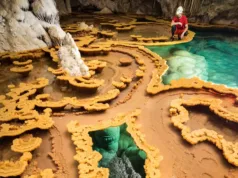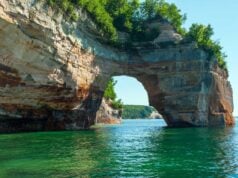Mono Lake is a unique and fascinating saline lake located in eastern California, USA, nestled within the picturesque Mono Basin. It lies just east of the Sierra Nevada mountain range and south of the city of Lee Vining.


Mono Lake is renowned for its otherworldly landscape and striking tufa towers, which are limestone formations that rise from the lake’s surface. The lake is highly saline and alkaline, making it inhospitable to most forms of aquatic life except for certain species of brine shrimp and alkali flies. Its high salinity is due to the lack of an outlet, leading to high levels of dissolved salts accumulating over time.
Surrounded by stark desert terrain, Mono Lake is bordered by the Sierra Nevada to the west and the Mono Craters to the south. The lake’s surroundings offer stunning vistas and opportunities for outdoor recreation, such as hiking, birdwatching, and photography. It serves as a critical habitat for migratory birds, including the California gull and various species of waterfowl, making it a significant destination for bird enthusiasts. Additionally, the area’s unique geological features and ecological significance have led to its designation as a National Natural Landmark and a protected area under the Mono Lake Tufa State Natural Reserve.
Geological Formation

Mono Lake’s geological history is deeply intertwined with the complex tectonic forces and climatic changes that have shaped the region over millions of years. The basin in which Mono Lake resides, known as the Mono Basin, formed through a combination of tectonic uplift and faulting associated with the ongoing movement of the Earth’s crust.
Around 760,000 years ago, volcanic activity in the region created the Mono Craters, a series of domes and lava flows that now flank the southern shore of the lake. As these volcanic eruptions occurred, they blocked natural drainage routes, allowing water to accumulate in the basin, forming what we now know as Mono Lake.
Tufa Towers:
The most iconic geological feature of Mono Lake is undoubtedly its tufa towers. These striking limestone formations are created through a process involving the interaction of freshwater springs rich in calcium with the alkaline waters of the lake.

Here’s how it happens:
- Freshwater springs, often originating from underground aquifers in the nearby mountains, carry dissolved calcium carbonate (limestone) towards the lake.
- When this calcium-rich water mixes with the alkaline waters of Mono Lake, a chemical reaction occurs. The calcium carbonate precipitates out of the water, forming solid deposits of limestone.
- Over time, these deposits accumulate and grow upwards, forming the distinctive tufa towers that dot the lake’s shoreline.
The significance of tufa towers lies not only in their unique and visually striking appearance but also in the insights they provide into the hydrological and geological processes at work in the Mono Basin. They serve as a tangible record of the interplay between freshwater sources and the saline lake waters, offering valuable clues about past environmental conditions and the lake’s evolution over time. Additionally, tufa formations provide crucial nesting sites for birds and habitats for other wildlife, contributing to the ecological diversity of the Mono Lake ecosystem.
Ecological Significance

The ecological significance of Mono Lake cannot be overstated. Despite its harsh and saline environment, the lake supports a remarkable array of life, making it a vital habitat for both resident and migratory species. Here are some key aspects of its ecological importance:
- Migratory Birds: Mono Lake serves as a critical stopover point for millions of migratory birds on the Pacific Flyway, one of North America’s major bird migration routes. Species such as California gulls, eared grebes, Wilson’s phalaropes, and numerous waterfowl species rely on the lake’s abundant food resources during their long journeys.
- Brine Shrimp and Alkali Flies: The lake’s high salinity supports thriving populations of brine shrimp and alkali flies. These tiny organisms form the base of the food web, providing essential sustenance for a variety of bird species, including migratory shorebirds and nesting gulls.
- Unique Adaptations: The extremophilic nature of Mono Lake has led to the evolution of unique adaptations among its inhabitants. Species such as the alkaline-tolerant brine shrimp and alkali flies have developed specialized physiological traits to thrive in the lake’s alkaline waters, making them uniquely suited to this environment.
- Biodiversity Hotspot: Despite its relatively small size, Mono Lake boasts impressive biodiversity, with over 80 species of birds recorded in the area. Additionally, the surrounding Mono Basin supports a diverse array of plant and animal life, including sagebrush scrubland, riparian habitats, and unique desert flora and fauna.
In summary, Mono Lake is not only a stunning natural wonder but also a crucial ecological resource, supporting a rich diversity of life and playing a vital role in the broader ecosystem of the Eastern Sierra region. Efforts to conserve and sustainably manage this unique environment are essential to ensuring its continued ecological significance for generations to come.




































